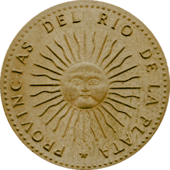Sun of May
|

The Sun of May (Spanish: Sol de Mayo) is a national emblem of Argentina and Uruguay, and appears on both countries' flags.
History
According to the historian Diego Abad de Santillán, the Sun of May is a figurative sun that represents Inti, the sun god of the Inca religion. Worshiped as a patron deity of the Inca Empire, Pachacuti is often linked to the origin and expansion of the Inca Sun Cult.[1][2]. The most common story says that he is the son of Viracocha, the god of civilization.[3]
The specification "of May" is a reference to the May Revolution which took place in the week from 18 to 25 May 1810, which marked the beginning of the independence from the Spanish Empire for the countries that were then part of the Viceroyalty of the Río de la Plata. A legend claims that as the new government was proclaimed, the sun broke through the clouds, which was seen as a good omen.
Variations
In the flag of Argentina, the Sun of May is the radiant golden yellow sun bearing the human face and thirty-two rays that alternate between sixteen straight and sixteen wavy.
In the flag of Uruguay, the Sun of May is the golden yellow sun bearing the human face and sixteen triangular rays that alternate between eight straight and eight wavy.
Description
The sun, called the Sun of May, is a replica of an engraving on the first Argentine coin, approved in 1813 by the Constituent Assembly, whose value was eight escudos (one Spanish dollar).
In form, it is similar to — and may be partially derived from — the sun in splendour, which is common in European heraldry. This, too, is usually depicted with a face, and with alternating straight and wavy rays (representing light and heat respectively),[4] though it normally has only sixteen rays.
A 1978 law describing the official ceremonial flag of Argentina specifies that the sun must be golden yellow in color (amarillo oro), have an inner diameter of 10 cm, and an outer diameter of 25 cm (the diameter of the sun equals 5⁄6 the height of the white stripe, and the sun's face is 2⁄5 of its height), must feature 32 rays (16 undulated and 16 straight in alternation),[5] and must be embroidered in the official ceremonial flag.
See also
References
- ↑ Steele & Allen 2004, pg. 246
- ↑ D'Altroy 2003, pg. 147
- ↑ Abad de Santillán, Diego (1965). Historia Argentina [Argentine history] (in Spanish). Buenos Aires: TEA (Tipográfica Editora Argentina). OCLC 9405703. Unknown ID 2900104629702.
- ↑ Fox-Davies, Arthur Charles (1969). A Complete Guide to Heraldry. Aylesbury: Thomas Nelson and Sons. p. 222. ISBN 978-0-17-144102-4.
- ↑ "Nuestra patria: bandera nacional" [Our fatherland: national flag] (in Spanish). Argentine Institute of Protocol and Public Relations. Archived from the original on April 14, 2009. Retrieved November 1, 2011.
Es un sol figurado con rostro humano, de color oro amarillo con treinta y dos rayos: 16 flamígeros apuntando o "girando" en sentido horario, y 16 rectos colocados alternativamente, según diseño de la primera moneda argentina.
External links
![]()

